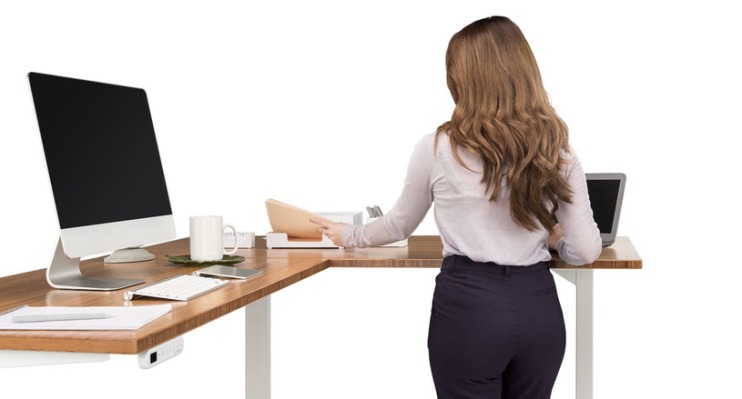
 Sitting can be hazardous to your health. That’s the conclusion of studies reported from the Spine Resource Clinic at the University of Washington, Women’s Health Magazine and the Journal of the American Chiropractic Association. The studies say sitting puts extra stress on your back, increases muscle tension, and results in “stagnant circulation,” as compared to standing. Chances are, you’re reading this from a sitting position, either at home or perhaps on a break at work. If so, I have two words for you: Get up.
Sitting can be hazardous to your health. That’s the conclusion of studies reported from the Spine Resource Clinic at the University of Washington, Women’s Health Magazine and the Journal of the American Chiropractic Association. The studies say sitting puts extra stress on your back, increases muscle tension, and results in “stagnant circulation,” as compared to standing. Chances are, you’re reading this from a sitting position, either at home or perhaps on a break at work. If so, I have two words for you: Get up.
In 2010, the American Cancer Society released a report finding that women who sat more than six hours a day were 37 percent more likely to die prematurely than women who sat for less than three hours; for men the figure was 18 percent. In 2011, a study by the American College of Cardiology found mortality increased among those who sat for long periods of time. Additionally, the British Journal of Sports Medicine found that obesity, diabetes, heart disease, cancer and even premature death could result from prolonged periods of sitting. Even for those who exercise, sedentary behavior is considered a risk factor.
One way to avoid the perils of sitting is to use a standing desk. Standing desks are just that — work stations at which the user is in a standing rather than a seated position. Regular desks are roughly 30 inches high while the standing variety can be as tall as 45 inches. Sarah Burnett of the Risk Management Office at the University of Vermont says there are a number of university employees who have requested standing desks. She hastened to add that she didn’t necessarily think one type of office furniture was better than another. Rather than dictate a particular work position, Burnett said she counsels workers to move around during the day. “Sitting and staring at a computer for four hours, let alone eight, is not good,” she said. “Your blood isn’t flowing and everything freezes up on you. You need to get up and move.”
Liz Dickson of Vermont’s Agency of Natural Resources has just started using a standing desk, in part because her commute has doubled since her office was moved from flood-ravaged Waterbury to Winooski. Dickson didn’t make the switch because of any trauma or physical difficulties. “I like to be active and don’t like to sit down all day,” she said. “With the increased commute, I felt so sedentary and my body just wasn’t happy.”
Initially, Dickson went for a low-tech solution, placing a cardboard box on her desk and using it for reading and non-computer writing. When she saw a colleague’s hydraulic desk which can be raised and lowered, she decided to make a change. Peter Moreman, the Facilities Manager at the VSAC building where Dickson is currently located, provided her with a sectional desk which allows her to use her computer while in a standing position but other functions while seated. Dickson said the key to using a standing desk is to wear comfortable shoes and stand on a cushioned mat.
Moreman said some employees who request standing desks do so based on a doctor’s recommendation while others have come up with the idea on their own; nobody has ever requested to return to their prior arrangements, even those for whom the doctor’s recommendation was only for a short period of time. Moreman cautions that there is no “100% one size fits all” solution for those with sedentary jobs and adds that many of those who request standing desks eventually also request tall chairs so they can alternate between sitting and standing. In general, Moreman believes standing is healthier than sitting because people tend not to sit up properly. “One advantage of standing over sitting,” he said “is you achieve the primary goal of keeping your head directly over your back so it’s supported directly. You simply can’t stand as badly as you might sit.”
Dr. David Little of Fletcher Allen Health Care worries that some of the studies on sitting have not isolated all the variables; perhaps people who sit for long periods also smoke, drink, or have unhealthy eating habits. Additionally, he recognizes that older workers may not find it comfortable to stand for long periods of time so he suggests that seniors intersperse periods of activity during the day with periods of rest.
Dr. John Scott of Northeast Vermont Regional Hospital – Corner Medical in Lyndonville said studies show that even people who follow the recommended federal guidelines of 30 minutes of brisk exercise at least five times a week can suffer negative effects from prolonged periods of sitting. Those with sedentary occupations and/or lifestyles have twice the risk of colon cancer, increased risk of other cancers, a 64 percent increase in risk for cardiovascular disease, as well as a greater propensity for diabetes and obesity. Scott cautions that there is no proof that standing desks are a panacea for these conditions. An Australian study showed that those who got up during the day and walked a bit had fewer metabolic abnormalities, but no change in other risk factors. However, just because standing and walking isn’t a cure-all doesn’t mean people shouldn’t try to change their position. “It certainly couldn’t hurt for people to get up more and not sit for a prolonged period of time,” said Scott. “I don’t see a downside.”
This article was contributed by Phyl Newbeck.
 Related Articles & Free Subscription
Related Articles & Free Subscription
Climb Stairs to Lower Blood Pressure and Strengthen Leg Muscles
How to Choose and Use a Home Blood Pressure Monitor





Comment here